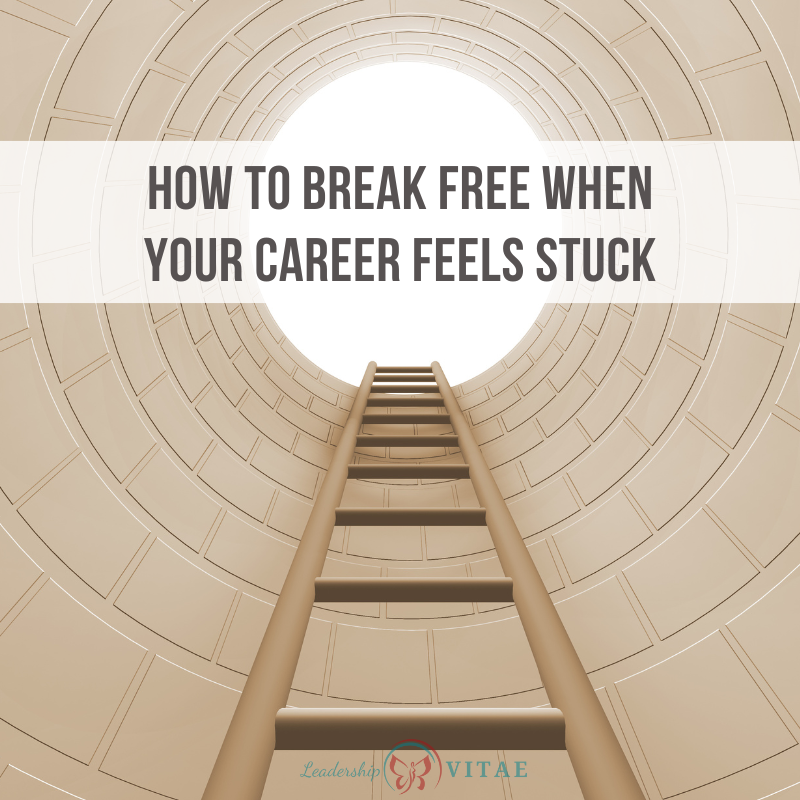
Have you ever felt like you’re trapped in a career quicksand, where every move seems to sink you deeper into frustration? You’re not alone. In fact, feeling “stuck” is a universal experience that many professionals encounter—and it’s rarely about a genuine lack of options. The truth is, we often create our own mental barriers, limiting our view of what’s possible.
The Story We Tell Ourselves
Take Sarah. A talented professional who saw a potential opportunity within her company. At first glance, the role looked eerily similar to a position she’d previously left—triggering an immediate sense of resistance. Her initial narrative was one of defeat: “This would be like going backwards.”
Sarah is all of us when we get trapped in our narratives and can’t find a way out. We’ve all been there—feeling stuck, believing our options are limited, convinced that moving forward means compromising our dreams.
But what if sideways could actually mean forward?
Through coaching, Sarah reframed her perspective. She explored the unique learning opportunities hidden in this role. What could she gain that she hadn’t considered before? Suddenly, the opportunity transformed from a potential setback to a strategic career move. Her energy shifted dramatically when she realized that her power lay not in the specific job title, but in her ability to turn any role into a learning experience.
From Stuck to Action
Getting unstuck is about reframing what’s possible. In Sarah’s case, it was one conversation that gave her the push to take action. While talking with a trusted advisor, mentor, or coach can certainly help us reframe our narratives, we can also help ourselves. The following practices have been shared with clients to help them work through where they are feeling stuck and move towards action.
1. Demolish Imaginary Obstacles
Are the barriers in your path real, or did you put them there yourself?
Our brains are wired to spot danger everywhere—it’s how we survived as a species. But in our careers, this instinct often creates phantom obstacles while making us blind to open pathways forward.
Ask yourself: What would I do if nothing was holding me back? That’s your clear runway. Which parts of this vision could you begin pursuing right now?
Then, examine what you believe stands in your way. Are these barriers truly immovable, or are they stories, assumptions, or well-meaning advice you’ve accepted as truth? Often, finding a path around just one obstacle creates momentum toward your destination.
Take Action: Set aside 30 minutes with your journal. First, describe your ideal career scenario without constraints. Next, identify any “clear runway” elements you could pursue immediately. Finally, list every perceived obstacle and challenge each one with: “Is this a real barrier or just a story I’m telling myself?” You’ll likely discover that many mountains in your path are merely hills—or exist only in your mind.
2. Create Opportunity Where You Stand
Luck is what happens when preparedness meets opportunity.
Seneca
While the grass may be greener elsewhere, the grass is green where you water it. We don’t need anyone’s permission to grow. We can invest in where we are today and grow it into a new opportunity that matches our aspirations.
If our current role isn’t the perfect fit, what skills or responsibilities would make it better? What could we bring to our work that would increase our engagement and passion?
I’ve made my career by raising my hand for opportunities—by asking my manager what they were losing sleep over and then tackling that problem. This approach allowed me to stay in one role for 6 years, with each year feeling like it was brand new.
This strategy works for anyone. You can volunteer for a special project, learn a new skill, or ask for a stretch assignment. Demonstrating initiative and eagerness to develop often creates the opportunities you’re hoping for—the very definition of luck.
Take Action: Schedule a 30-minute conversation with your manager. Come prepared with a skill you’re passionate about and would like to develop further. Share how this skill could benefit your current role and the broader team. Ask for guidance on stretch opportunities or projects that could help you lean into and develop this skill. Be specific about your learning goals and show how they align with team or organizational objectives.
3. Take One Strategic Step
Often, where we are can’t get us where we’re going. It’s “what got us here won’t get us there” with a twist. We may have to put in some additional work to bridge the gap from where we are to where we want to be.
I often suggest to clients that they evaluate the roles they aspire to and capture the skills and practical experience needed. From there, any gaps that cannot be addressed in the current role, even after steps 1 & 2, require a bridge strategy.
Maybe there’s a dream job you’re after. With job requirements and skill gaps in hand, you can pursue a transition role to get closer to your goal.
Consider my own path: It took me 10 years to move from a role in technology to human-centered change. During that time, I took on a LOT of technology jobs across different companies. I wasn’t being redirected or failing to achieve my goal. Instead, I was building the human-centered skills I needed to supplement my transferrable skills in change management.
I’m not suggesting that you need to take 10 years to achieve your goal. However, that straight line may have to take a twist or turn to get to the end goal.
Take Action: Create a skills matrix comparing your current role with your target role. List out the key competencies required for your dream position. Identify the gaps between your current skill set and what’s needed. Choose one skill gap (ideally one with high impact that you’re genuinely interested in) and develop a concrete learning plan. This might mean taking a course, engaging a mentor, or looking into a loan or rotational assignment. The goal is to make tangible progress, even if it’s just one small step at a time.
The Power of Your Narrative
After all these strategies, we arrive at the most fundamental truth: your brain will believe whatever story you repeatedly tell it. Say “I’m stuck” often enough, and your world literally shrinks—possibilities fade, paths narrow, and opportunities vanish from view.
Don’t like your current options? Create new ones. The sensation of being stuck is just that—a feeling vs an immovable reality. It’s a mental construct that confines your vision, reducing your world to your present frustration.
What story are you currently telling yourself about your career? How might that narrative be limiting your options? Take a moment now and identify one small step you can commit to taking this week—a step that begins rewriting your story.
I’d love to hear about it in the comments below. Your journey might be exactly the inspiration someone else needs to break free from their own stuck narrative—and in sharing, you might discover perspectives you hadn’t considered before.








